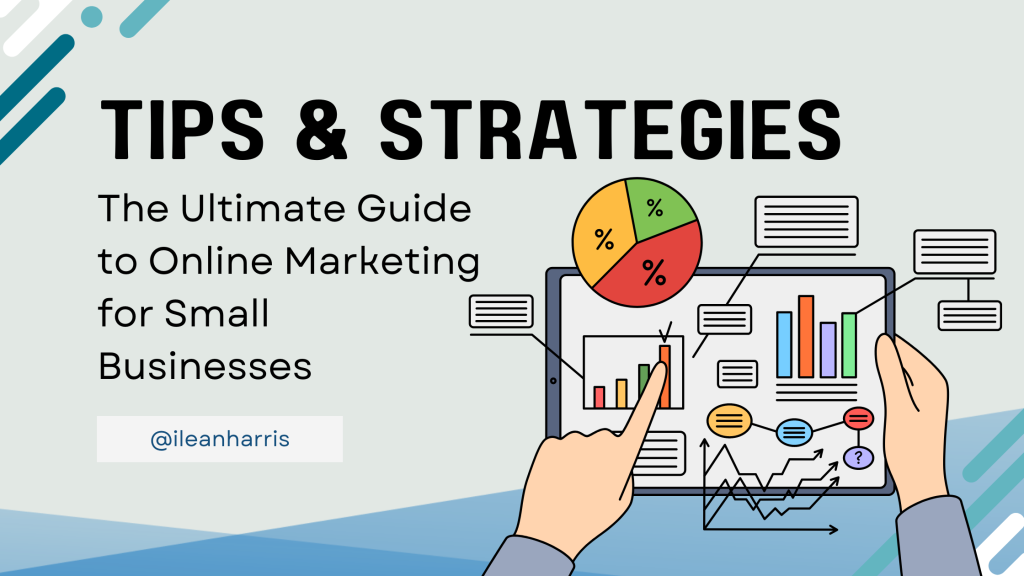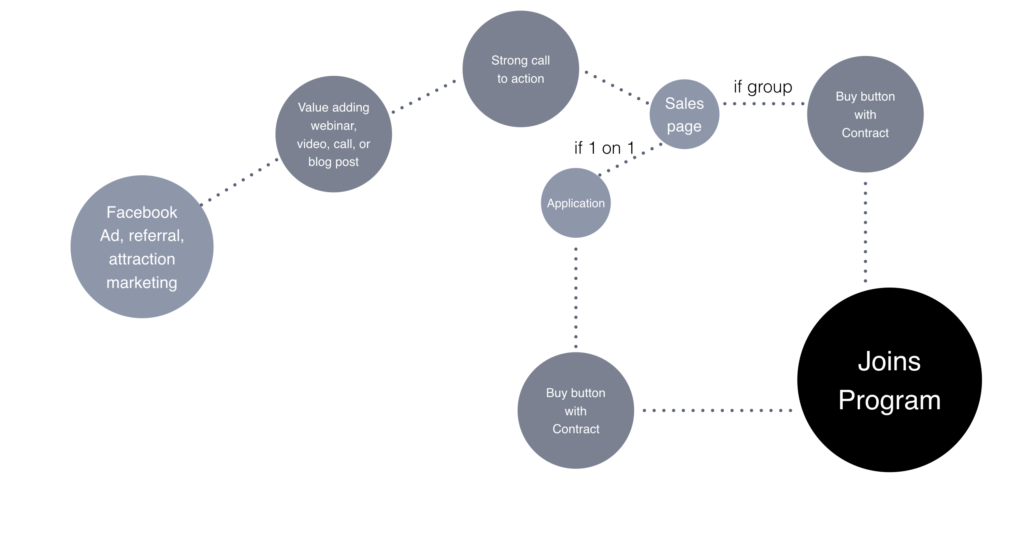This post is all about marketing for small business.

The Ultimate Guide to Online Marketing for Small Businesses: Tips and Strategies
As a small business owner, online marketing can be a game-changer when it comes to reaching new customers and growing your business.
Without a great online marketing strategy, I wouldn’t have clients in over 20 countries and in over 100 niches. If I did it, you can too!
You don’t need millions of followers nor do you need to have a staff of 100 people to succeed online.
However, with so many options and strategies to choose from, it can be overwhelming to know where to start.
In this ultimate guide to online marketing for small businesses, we’ll share tips and strategies to help you navigate the world of online marketing and achieve success.
Marketing For Small Business
- Define Your Target Audience
The first step in any online marketing strategy is to define your target audience. Who are your ideal customers? What are their needs, interests, and pain points? By understanding your target audience, you can create content and marketing campaigns that resonate with them and drive engagement.
- Create a Website
A website is essential for any small business looking to establish a strong online presence. Your website should be user-friendly, visually appealing, and optimized for search engines. It should also provide information about your products or services and make it easy for visitors to contact you.
- Use Search Engine Optimization (SEO)
SEO is the process of optimizing your website to rank higher in search engine results pages (SERPs). By using relevant keywords, creating high-quality content, and building backlinks, you can improve your website’s visibility and attract more organic traffic.
- Invest in Pay-Per-Click (PPC) Advertising
PPC advertising allows you to place ads on search engine results pages and other websites. With PPC advertising, you only pay when someone clicks on your ad. This makes it a cost-effective way to reach new customers and drive conversions.
- Use Social Media
Social media platforms like Facebook, Twitter, and Instagram provide a powerful way to reach your target audience and build relationships with your customers. By sharing valuable content, engaging with your followers, and running targeted ads, you can use social media to drive traffic to your website and increase sales. Learn more about social media for small business.
- Email Marketing
Email marketing is a cost-effective way to nurture leads and build relationships with your customers. By sending personalized, targeted emails, you can provide value to your subscribers and promote your products or services.
- Analyze and Optimize
Finally, it’s important to regularly analyze and optimize your online marketing efforts. Use tools like Google Analytics to track website traffic, engagement, and conversion rates. Use this data to make informed decisions and continually improve your marketing strategy.
Overall, online marketing is an essential component of any small business strategy.
By defining your target audience, creating a website, using SEO, investing in PPC advertising, using social media, email marketing, and regularly analyzing and optimizing your efforts, you can achieve success and grow your business.
How to leverage sales funnels for your marketing for your small business
Sales funnels are a powerful marketing tool for small businesses looking to increase conversions and generate more revenue.

A sales funnel is a series of steps designed to guide potential customers through the buying process, from awareness to purchase.
Learn how to create a sales funnel on auto-pilot that generates sales and leads daily here now.
Let’s explore how to leverage sales funnels for your marketing and grow your small business.
- Define Your Sales Funnel
The first step in leveraging sales funnels for your marketing is to define your funnel. Your sales funnel should reflect your customer’s journey, from becoming aware of your product or service to making a purchase. Map out the steps in your funnel, such as lead generation, lead nurturing, and conversion.
- Create High-Quality Content
High-quality content is essential for attracting potential customers to your sales funnel. Create blog posts, social media posts, videos, and other content that provides value to your target audience. Use this content to drive traffic to your website and capture leads.
- Capture Leads
Once you’ve attracted potential customers to your website, it’s important to capture their contact information. Use lead magnets, such as free e-books or webinars, to entice visitors to provide their email address or other contact information.
- Nurture Leads
Once you’ve captured leads, it’s important to nurture them through your sales funnel. Use email marketing, retargeting ads, and other tactics to provide value and encourage potential customers to move through the funnel.
- Close the Sale
The final step in your sales funnel is to close the sale. Use persuasive copy, testimonials, and other tactics to encourage potential customers to make a purchase. Make it easy for them to buy by providing clear calls to action and a simple checkout process.
- Analyze and Optimize
Finally, it’s important to regularly analyze and optimize your sales funnel. Use tools like Google Analytics to track metrics like conversion rates, bounce rates, and click-through rates.
Use this data to identify areas for improvement and continually optimize your funnel for better results.
In conclusion, leveraging sales funnels for your marketing is a powerful way to increase conversions and grow your small business.
By defining your funnel, creating high-quality content, capturing leads, nurturing leads, closing the sale, and regularly analyzing and optimizing your funnel, you can achieve success and generate more revenue.
Top mistake to avoid when marketing for small business
Marketing is an essential component of any small business strategy, but it’s easy to make mistakes that can hinder your success.
Let’s go over the top mistakes to avoid when marketing for small business and how to overcome them.
- Not Defining Your Target Audience
One of the biggest mistakes small businesses make is not defining their target audience. If you don’t know who your ideal customer is, you can’t create marketing campaigns that resonate with them. Define your target audience by researching their demographics, interests, and pain points, and create marketing campaigns that address their needs.
- Focusing Too Much on Your Product or Service
Another common mistake is focusing too much on your product or service and not enough on your customer’s needs. Instead of talking about what you offer, focus on how your product or service can solve your customer’s problems or improve their lives.
- Neglecting Your Online Presence
In today’s digital age, having a strong online presence is essential. Neglecting your website, social media profiles, and other online channels can hurt your credibility and make it difficult to reach new customers. Invest in your online presence by creating high-quality content, engaging with your followers, and regularly updating your profiles.
- Not Using Analytics to Measure Results
Marketing without analytics is like driving without a map. Without measuring your results, you can’t know what’s working and what’s not. Use tools like Google Analytics to track metrics like website traffic, engagement, and conversion rates. Use this data to make informed decisions and optimize your marketing campaigns for better results.
- Trying to Do Everything at Once
Finally, trying to do everything at once can lead to burnout and poor results. Instead, focus on a few key marketing channels and strategies that are most likely to reach your target audience. This will allow you to allocate your resources more effectively and achieve better results.
Overall, marketing is a critical component of any small business strategy, but it’s important to avoid common mistakes that can hinder your success.
By defining your target audience, focusing on your customer’s needs, investing in your online presence, using analytics to measure results, and focusing on key marketing channels and strategies, you can achieve success and grow your business.
How to identify what marketing is right for your small business
As a small business owner, it can be overwhelming to decide which marketing strategies to use to promote your products or services.
With so many options available, it’s important to identify the marketing methods that are right for your business.
Here are some steps to help you identify the best marketing strategies for your small business:
- Define Your Goals
Before deciding on any marketing strategies, it’s important to define your goals. Do you want to increase brand awareness, drive website traffic, generate leads, or increase sales? By defining your goals, you can determine which marketing methods are most likely to achieve those goals.
- Know Your Target Audience
Understanding your target audience is key to determining which marketing strategies are most effective. Who are your ideal customers? What are their pain points and interests? Knowing your audience will help you choose marketing methods that resonate with them and attract their attention.
- Evaluate Your Resources
Consider your budget, time, and expertise when deciding on marketing strategies. Some strategies, such as social media marketing, can be done in-house with minimal costs, while others, such as hiring a marketing agency, can require a significant investment. Be realistic about what resources you have available and choose strategies that align with them.
- Research Your Competition
Research your competition to see what marketing strategies they are using. This can help you identify which strategies are working in your industry and give you ideas for your own campaigns.
- Test and Measure
Finally, it’s important to test and measure your marketing campaigns. Start small and test different methods to see what works best for your business.
Learn more about how to turn your passions into an online business here.
Use analytics tools to track metrics like website traffic, engagement, and conversion rates. Use this data to make informed decisions and optimize your campaigns for better results.
Identifying the right marketing strategies for your small business requires careful consideration of your goals, target audience, resources, competition, and testing and measuring.
By taking these steps, you can choose marketing methods that are most likely to achieve your goals and grow your business.
This post was all about marketing for small business.






